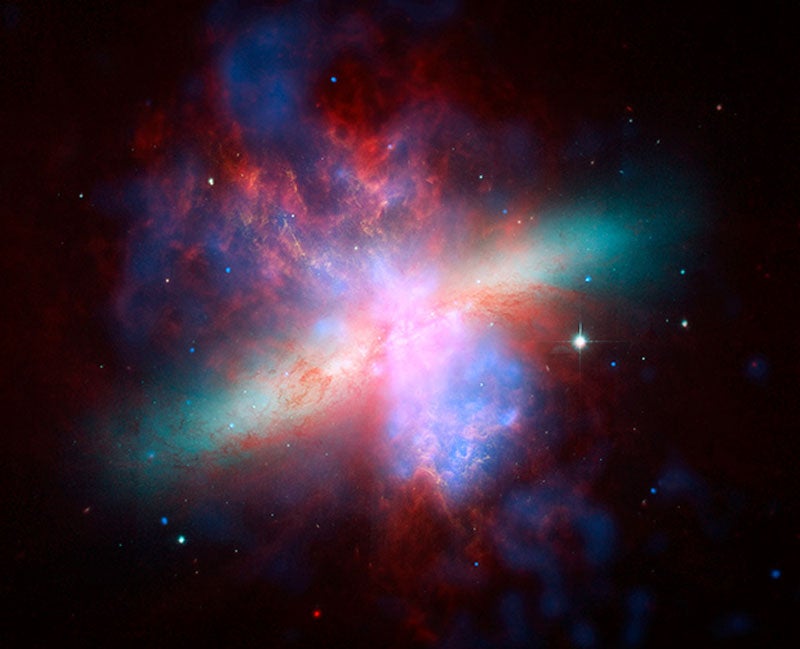M82 is a starburst galaxy where stars are forming at rates that are tens or even hundreds of times higher than in a normal galaxy. The burst of star birth may be caused by a close encounter or collision with another galaxy, which sends shock waves rushing through the galaxy. In the case of M82, astronomers think that a brush with its neighbor galaxy M81 millions of years ago set off this torrent of star formation.
M82 is seen nearly edge-on with its disk crossing from about 10 o’clock to about 4 o’clock in this image from Chandra — low, medium, and high-energy X-rays are colored red, green, and blue, respectively. Among the 104 point-like X-ray sources in the image, eight so far have been observed to be bright in X-rays and undergo clear changes in brightness over periods of weeks and years. This means they are excellent candidates to be black holes pulling material from companion stars that are more massive than the Sun. Only a handful of such binary systems are known in the Local Group of galaxies containing the Milky Way and M31.
Chandra observations are also important in understanding the rapid rate at which supernovae explode in starburst galaxies like M82. When the shock waves travel through the galaxy, they push on giant clouds of gas and dust, which causes them to collapse and form massive stars. These stars, in turn, use up their fuel quickly and explode as supernovae. These supernovas produce expanding bubbles of multi-million-degree gas that extend for millions of light-years away from the galaxy’s disk. These bubbles are seen as the large red areas to the upper right and lower left of the image.
M82 is a starburst galaxy where stars are forming at rates that are tens or even hundreds of times higher than in a normal galaxy. The burst of star birth may be caused by a close encounter or collision with another galaxy, which sends shock waves rushing through the galaxy. In the case of M82, astronomers think that a brush with its neighbor galaxy M81 millions of years ago set off this torrent of star formation.
M82 is seen nearly edge-on with its disk crossing from about 10 o’clock to about 4 o’clock in this image from Chandra — low, medium, and high-energy X-rays are colored red, green, and blue, respectively. Among the 104 point-like X-ray sources in the image, eight so far have been observed to be bright in X-rays and undergo clear changes in brightness over periods of weeks and years. This means they are excellent candidates to be black holes pulling material from companion stars that are more massive than the Sun. Only a handful of such binary systems are known in the Local Group of galaxies containing the Milky Way and M31.
Chandra observations are also important in understanding the rapid rate at which supernovae explode in starburst galaxies like M82. When the shock waves travel through the galaxy, they push on giant clouds of gas and dust, which causes them to collapse and form massive stars. These stars, in turn, use up their fuel quickly and explode as supernovae. These supernovas produce expanding bubbles of multi-million-degree gas that extend for millions of light-years away from the galaxy’s disk. These bubbles are seen as the large red areas to the upper right and lower left of the image.










